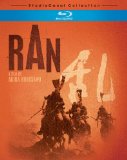| Reviews & Columns |
|
Reviews DVD TV on DVD Blu-ray 4K UHD International DVDs In Theaters Reviews by Studio Video Games Features Collector Series DVDs Easter Egg Database Interviews DVD Talk Radio Feature Articles Columns Anime Talk DVD Savant Horror DVDs The M.O.D. Squad Art House HD Talk Silent DVD
|
DVD Talk Forum |
|
|
| Resources |
|
DVD Price Search Customer Service #'s RCE Info Links |
|
Columns
|
|
|
Ran -- StudioCanal Collection
Lionsgate Home Entertainment // R // February 16, 2010
List Price: $39.99 [Buy now and save at Amazon]
The Film:
Ran marks the second semi-direct adaptation of William Shakespeare's work from Akira Kurosawa (the first being Throne of Blood, an adaptation of "Macbeth"), along with it being his most expensive picture -- $12million, the most of any Japanese production at that time. The investment can be seen throughout every single frame of the film, with over a thousand extras adorned with slaved-over suits of armor, a sumptuous amount of colorful location-heavy photography, and quite a few dazzling battle sequences that include a myriad of bloody spurts and engulfing flames. All of this was sketched out by Kurosawa in paintings, occurring as he was stewing over the picture for many, many years after he wrote it. What does all of this mean? That the director placed a mesmeric amount of work into his final epic production, and it all shows in this breath-snatching, boldly involving masterwork.
Ran adapts Shakespeare's "King Lear" to a loose degree, capturing the downfall of the Ichimonji family as the aging, once-violent patriarch Hidetora, played by a nearly unrecognizable Tatsuya Nakadai, abdicates and divides his rule among his three sons with head authority going to the eldest. He illustrates the situation with a batch of three arrows together, claiming that the three supporting one another in the power structure will result in an indestructible bond -- though Hidetora still wishes to remain the "Great Lord", thus not bequeathing direct rule to any of them. As to be expected of strong males brought up in royalty, his eldest sons Taro and Jiro deviate from their father's wishes and exert muscle over one another, and their father, to claim the throne. The conflict quickly escalates into a movement of pawns and manipulations, resulting in a tumultuous downfall for Hidetora as his eldest sons plot with bloodlust in their eyes. The only people he ends up being able to trust are his youngest son, Saburo, and his gender-challenged jester Tango, both of whom stay loyal even though he shuns them undeservedly for warning him of potential treachery.
With a title translated to mean "revolt" or "rebellion", Ran begins with relatively peaceful talks between family members and bureaucrats after a boar hunt, surrounded by crisp yellow sun-and-moon tapestries with the participants sitting underneath a crystal clear sky. We're given a subdued glimpse into the precision behind Kurosawa's filmic construction with this initial sequence, allowing us to view a broad range of colors both in his cinematography and in the intricate costume design. Their lackadaisical meeting smoothly transitions between calmness to aggravation, illustrating the subtlety behind each of the performances as conversation shifts to potential treachery, backstabbing, and Hidetora's plummeting capacity to grasp reality. Clearly, this is the relative calm before a massive storm, symbolized by the flowing of clouds that slowly begins to intensify throughout this lengthy conversation.
Kurosawa's picture quickly engulfs into a manifestation of chaos that proves the two eldest brothers have just as much bite as bark, tossing around Hidetora like he's little more than a disposable resource -- much in the way Hidetora himself obtained the throne. Adultery, backstabs, and military strategy complicate the narrative, leaving no one unscathed as power consumes their worlds. What makes Ran so impressive is the way Kurosawa keeps it all exceedingly legible, and overwhelming evocative, even when the political strings overlap and entangle. As the maze-like complications create a quick scramble up the totem pole of power within the collapsing Ichimonji clan, and Hidetora plummets into a world of disenchanted lunacy, Kurosawa keeps our focus centered more on the characters than all the plotting. He allows it to appear labyrinthine and complex to a point that's out of reach, being the way anarchy should rightfully appear, while focusing intently on the characters' knee-jerk reactions to the events that unfurl.
As engrossing as the story can be, Ran's real draw comes in the artistry behind its battle sequences and photography. When Kurosawa discovered color with Dodes'ka-den, he played with a wild level of coloring like a young person who's discovered fingerpaints in all shades of the rainbow, later controlling and mastering the new technology with Kagemusha -- often considered to be the director's dress rehearsal for his final epic. Here, he controls the limits of color brashness and battle intensity, showcasing exactly where to create density of visuals and where to allow the poeticism within the shots to speak for themselves. It shows within the large battle sequence at the very center of the film; he closes in on a shot of Hidetora sitting in a room engulfed in flames, mentally destroyed by the activities, while a storm of arrows and trodden yellow / red armor create a metaphoric "man-made fire" through their violence outside the palace. With bloody warfare, lush color timing, and the persistent symbolism behind clouds -- growing their thickest and darkest at this point -- Ran reaches a pinnacle here that's awe-inspiring, easily one of the great moments in the director's career.
One of Kurosawa's biggest assets, though only utilized a handful of times in his catalog, lies in his ability to gracefully send us stair-stepping downwards into tragedy within a third act, knowing when to shove us through the pain and when to catch us to allow a scene's impact to really sink in. Ran's probably the most graceful and affective exhibit of that talent. Several complex sub-plots convene throughout the film's swelling conclusion, which includes the climax to feminine manipulation of men in power and the discovery of one of Hidetora's illegitimate children, and it all punches with just the right amount of might within each. Moreover, the path that we travel down regarding Hidetora's insanity illuminates the effects of a crumbling empire -- and a dying family -- on its patriarch. It's largely due to the corpse-like look to Tatsuya Nakadai's gaunt disposition and full-on elderly make-up, a tactic that harks back to classic Japanese theater to emphasize his pain and internal suffering. He's a ghost of his old self, both literally and figuratively, and it's transfixing to witness his slow deterioration.
In Shakespearean fashion, Ran doesn't disappoint with its conclusive plummet into self-destruction, building into a resolution that causes the destructive desires of powerful men to consume everyone within their sphere of influence. Messages stir within the billowing fires and gunshots near its conclusion about the consuming nature of warfare and supremacy, as we witness the faceless foot soldiers of the Ichimonji clan destroy the remnants of the empire that once was. It's expected of men with nothing but a lust for power in their eyes, and the grand scale within Kurosawa's construction of their brotherly vying for power, and heartless resolve for their father, is excruciatingly potent. Quite simply, Ran stands as the accumulation of 40+ years of filmmaking, a project still able to thrive in a environment rife with funding issues and perfectionist pressure from the legendary director. Though it caused rifts with its construction, it's a magnificently orchestrated piece of grand-scaled cinema that deserves every ounce of celebration it receives.
The Blu-ray:
Lionsgate's presentation of the StudioCanal Series differ a bit from the versions found in other locations, opting away from the Blu-ray books for the more standard-size packaging. Each one comes with a matte cardboard slipcover, not shiny, that retains the same artwork found in other locations, while a nice-sized booklet with textual information can be found inside each case. Each of the StudioCanal discs have the same aesthetic framework for their Blu-ray menus, containing the same music and coloring for each. Oddly, this presentation for Ran doesn't have the same initial multi-country menu as the StudioCanal presentation for Contempt, though the language and subtitle options are largely similar between the two.
Video and Audio:
Nothing would please me more than to give a full-throated, overwhelmingly positive recommendation of this Blu-ray transfer for Ran, which is properly framed at 1.85:1 within a pleasingly colorful 1080p VC-1 encode, but that's just not going to happen. In short, Kurosawa's film isn't done due diligence here, sporting a wealth of issues that mar this gorgeous film. The most notable issue comes in severe edge enhancement spotted throughout the picture, which creates thick halos around most sequences sporting moderately stark contrast. While on the topic of contrast, many scenes are blown out of proportion and sport some rather unattractive black levels, creating detail-swallowing darkness and overly bright points. Aside from that, we've also got a relatively flat level of dimensionality here and, moreover, a rather abundant level of digital grain that stretches beyond the confines of natural film texture.
There are a few notable upgrades in the image from Criterion's standard-definition presentation, however. Detail has been tightened to an extent here, rendering crisp, clean lines in the set design and against the actors -- when the edge enhancement isn't claiming our focus. Also, many instances of the costume work pop with attractive detail and color gradation in ways that they couldn't before. The cinematography still looks attractive (how could it not) and many of the flesh tones and brash colors are accurate and pleasing; however, that doesn't steer from the impression that Ran looks mostly digital and flat, veering away from delicacy of construction and into a mess of harshness. It's nice to have Ran in high-definition and flow at 24fps, as inherent with the Blu-ray tech, but we could've had a far, far better representation of this stunning film than this. There are a handful of impressive moments that don't fall under its problematic issues (such as a great, somewhat close-up still shot of Nakadai baking in the sun, with horses behind him and his sun / moon staff nearby), but they're very few and far between.
Audio, however, has greatly been improved in this Japanese DTS HD Master Audio track, a nicely-mixed multichannel presentation that surprises with its surround capacity. Ambient effects come streaming from the rear channels, like locusts and birds, along with powerful musical cues. It displays a similarly clear manner to that of Criterion's 2.0 presentation, supporting the raspy high-end swipes of arrows and gunshots to stable, low-distortion degrees. The musical elements during the storm on Hidetora's location at the middle of the film are sumptuous and pleasing, adding a true sense of grandeur to the pivotal sequence. What'll really impress is the nature of billowing fire during this sequence, which begins as gently lapping fire and builds into a crackling, swollen array of flames. Verbal clarity stays crisp and pleasing throughout, naturally a little high-level leaning in quite a few sequences, while the range of middle-range sound effects test the LFE waters water to satisfying degrees. Though the visual presentation leaves something to be desired, this sound option is certainly a robust step above its predecessors. Subtitles, which are crisp white and textually satisfying, are available in a broad range of optional languages -- English, Francais, Deutsch, Castellano, Italiano, Espanol, Nederlands, Dansk, Norsk, Suomi, and Svenska.
Special Features:
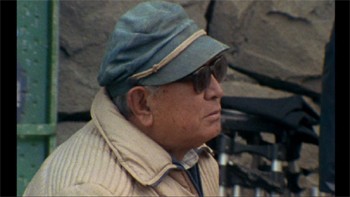 AK (1:11:32, SD MPEG-2):
AK (1:11:32, SD MPEG-2):
Previously available on Criterion's two-disc presentation, this documentary from filmmaker Chris Marker (director of La Jetee, the short that 12 Monkeys is based on) is a pensive and calculated feature that remains highly intimate throughout. Behind-the-scenes sequences from the film showcase Kurosawa's directorial methods, while the narrator elucidates the scenes we're watching with further explanations behind his tactics -- such as his need to rehearse for hours for one take. This piece does an interesting job of revealing the costume design from Ran as well, capturing some unique images like samurai strolling between a row of cars. Marker's doc gives us the times and dates for each of the sequences he's photographing, all while making certain to capture Kurosawa instructing his cast and crew excellently. It's a lengthy piece that might require a bit of stop-and-go due to its deliberateness, but the material's excellent.
Akira Kurosawa: The Epic and the Intimate (41:49, SD MPEG-2):
Focus falls on producer Serge Silberman and Kurosawa within this piece, featuring interviews with Ulli Pickardt, Bernard Cohn, Bertrand Raison, Vittorio Dalleore, and others that cover everything about Kurosawa's methodology. They address his focus on actors, the implementation of his simultaneous three-camera arrangements, and how his work has changed throughout the years. They discuss the realism and history behind his productions, concentrating more on Ran as the piece progresses, as well as his laborious and oftentimes obsessive attention to detail. Only footage from Ran, however, appears in the piece.
The Samurai (52:47, SD MPEG-2):
This is, quite simply, an overview of the samurai that also wiggles in elements on how he exists in cinema. It ties authenticity to the genre we're involved in, including the construction behind the weapons, the concept of samurai "looking their best" when going into battle, the ritualistic tea ceremony, and other elements. Samurai fighting techniques and etiquette also make their way roughly halfway into the piece, which includes training involving bokken and learning to use the bow and arrow on horseback. We're given equal doses of history and demonstration, which keeps the doc well-balanced all the way through.
Art of the Samurai (41:11, SD MPEG-2):
Jean-Christophe Charbonnier, a specialist on the topic of Japanese warfare, takes us through the implementation of weaponry, armor, and suicide utilized in Ran. He discusses why certain suicides aren't considered hara kiri, as well as what specific items in the suit of armor mean and how they're constructed. He makes use of a suit of armor next to him to further illustrate his points, which helps when he gets more in-depth. It's a lengthy, drawn-out piece, but still insightful.
Capping off the special features, Ran also comes with a StudioCanal-based Trailer (2:00, SD MPEG-2) that fits the tone of the picture perfectly. The disc has also been enabled with BD-LIVE, but the service wasn't active at the time of this review. Sadly, we're missing a few things here that really bolster the Criterion standard-definition package into something special -- including a nice commentary from Stephen Price, as well as the collection of Kurosawa's paintings illustrated in the Image: Kurosawa's Continuity feature.
Final Thoughts:
Akira Kurosawa directed many, many great films, but he only created a handful of tried-and-true masterworks -- and Ran's one of them. It's a brilliantly tragic take on Shakespeare's "King Lear", one that entrances with its visuals and and knocks one aback with its precision of theatrical delivery. Meticulousness from Kurosawa's eye can be seen within almost every glorious shot, showcasing the beauty that can come from rigid structure and perfectionism. He clearly left the business of crafting epic-scaled theatrical samurai drama with a memorable bang, one that's still as visually and thematically stunning as the day it was first screened at the Tokyo International Film Festival.
It'd be hard not to recommend any version of Ran, but this StudioCanal version comes dangerously close; though the sound quality and special features are both quite good here, the awesome cinematography could've looked a hell of a lot better than what's available in this high-definition presentation. Those who already own Ran via Criterion's stellar two-disc presentation will want to hold onto it, mainly for the special features that aren't on StudioCanal's disc. With that in mind, this Blu-ray of Ran still comes very timidly Recommended as both a supplement to the previous edition and to newcomers, since it improves ever-so-slightly over the standard-definition presentation. However, those that already have a copy of this great film might simply want to weigh whether a give-and-take improvement over the DVD's image, as well as in the special features department, will be worth the time.
Note: Screenshots from this review are from the standard-definition release of Ran, and do not reflect the quality of this Blu-ray disc.
Thomas Spurlin, Staff Reviewer -- DVDTalk Reviews | Personal Blog/Site
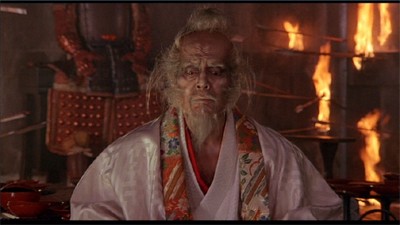 |
Ran adapts Shakespeare's "King Lear" to a loose degree, capturing the downfall of the Ichimonji family as the aging, once-violent patriarch Hidetora, played by a nearly unrecognizable Tatsuya Nakadai, abdicates and divides his rule among his three sons with head authority going to the eldest. He illustrates the situation with a batch of three arrows together, claiming that the three supporting one another in the power structure will result in an indestructible bond -- though Hidetora still wishes to remain the "Great Lord", thus not bequeathing direct rule to any of them. As to be expected of strong males brought up in royalty, his eldest sons Taro and Jiro deviate from their father's wishes and exert muscle over one another, and their father, to claim the throne. The conflict quickly escalates into a movement of pawns and manipulations, resulting in a tumultuous downfall for Hidetora as his eldest sons plot with bloodlust in their eyes. The only people he ends up being able to trust are his youngest son, Saburo, and his gender-challenged jester Tango, both of whom stay loyal even though he shuns them undeservedly for warning him of potential treachery.
With a title translated to mean "revolt" or "rebellion", Ran begins with relatively peaceful talks between family members and bureaucrats after a boar hunt, surrounded by crisp yellow sun-and-moon tapestries with the participants sitting underneath a crystal clear sky. We're given a subdued glimpse into the precision behind Kurosawa's filmic construction with this initial sequence, allowing us to view a broad range of colors both in his cinematography and in the intricate costume design. Their lackadaisical meeting smoothly transitions between calmness to aggravation, illustrating the subtlety behind each of the performances as conversation shifts to potential treachery, backstabbing, and Hidetora's plummeting capacity to grasp reality. Clearly, this is the relative calm before a massive storm, symbolized by the flowing of clouds that slowly begins to intensify throughout this lengthy conversation.
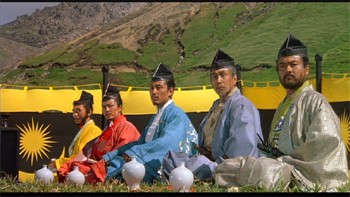 | 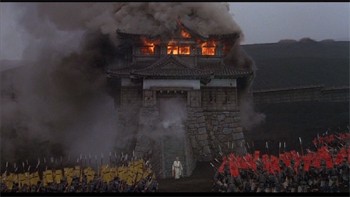 |
Kurosawa's picture quickly engulfs into a manifestation of chaos that proves the two eldest brothers have just as much bite as bark, tossing around Hidetora like he's little more than a disposable resource -- much in the way Hidetora himself obtained the throne. Adultery, backstabs, and military strategy complicate the narrative, leaving no one unscathed as power consumes their worlds. What makes Ran so impressive is the way Kurosawa keeps it all exceedingly legible, and overwhelming evocative, even when the political strings overlap and entangle. As the maze-like complications create a quick scramble up the totem pole of power within the collapsing Ichimonji clan, and Hidetora plummets into a world of disenchanted lunacy, Kurosawa keeps our focus centered more on the characters than all the plotting. He allows it to appear labyrinthine and complex to a point that's out of reach, being the way anarchy should rightfully appear, while focusing intently on the characters' knee-jerk reactions to the events that unfurl.
As engrossing as the story can be, Ran's real draw comes in the artistry behind its battle sequences and photography. When Kurosawa discovered color with Dodes'ka-den, he played with a wild level of coloring like a young person who's discovered fingerpaints in all shades of the rainbow, later controlling and mastering the new technology with Kagemusha -- often considered to be the director's dress rehearsal for his final epic. Here, he controls the limits of color brashness and battle intensity, showcasing exactly where to create density of visuals and where to allow the poeticism within the shots to speak for themselves. It shows within the large battle sequence at the very center of the film; he closes in on a shot of Hidetora sitting in a room engulfed in flames, mentally destroyed by the activities, while a storm of arrows and trodden yellow / red armor create a metaphoric "man-made fire" through their violence outside the palace. With bloody warfare, lush color timing, and the persistent symbolism behind clouds -- growing their thickest and darkest at this point -- Ran reaches a pinnacle here that's awe-inspiring, easily one of the great moments in the director's career.
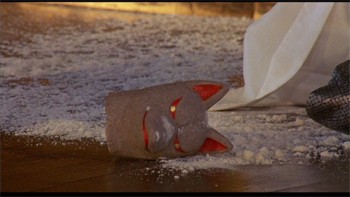 | 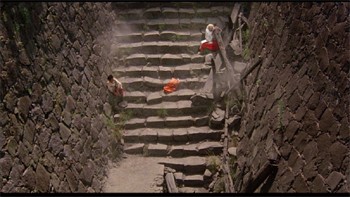 |
One of Kurosawa's biggest assets, though only utilized a handful of times in his catalog, lies in his ability to gracefully send us stair-stepping downwards into tragedy within a third act, knowing when to shove us through the pain and when to catch us to allow a scene's impact to really sink in. Ran's probably the most graceful and affective exhibit of that talent. Several complex sub-plots convene throughout the film's swelling conclusion, which includes the climax to feminine manipulation of men in power and the discovery of one of Hidetora's illegitimate children, and it all punches with just the right amount of might within each. Moreover, the path that we travel down regarding Hidetora's insanity illuminates the effects of a crumbling empire -- and a dying family -- on its patriarch. It's largely due to the corpse-like look to Tatsuya Nakadai's gaunt disposition and full-on elderly make-up, a tactic that harks back to classic Japanese theater to emphasize his pain and internal suffering. He's a ghost of his old self, both literally and figuratively, and it's transfixing to witness his slow deterioration.
In Shakespearean fashion, Ran doesn't disappoint with its conclusive plummet into self-destruction, building into a resolution that causes the destructive desires of powerful men to consume everyone within their sphere of influence. Messages stir within the billowing fires and gunshots near its conclusion about the consuming nature of warfare and supremacy, as we witness the faceless foot soldiers of the Ichimonji clan destroy the remnants of the empire that once was. It's expected of men with nothing but a lust for power in their eyes, and the grand scale within Kurosawa's construction of their brotherly vying for power, and heartless resolve for their father, is excruciatingly potent. Quite simply, Ran stands as the accumulation of 40+ years of filmmaking, a project still able to thrive in a environment rife with funding issues and perfectionist pressure from the legendary director. Though it caused rifts with its construction, it's a magnificently orchestrated piece of grand-scaled cinema that deserves every ounce of celebration it receives.
The Blu-ray:
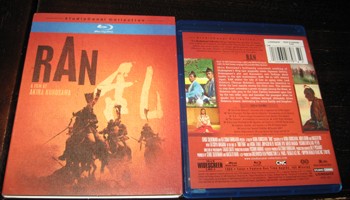 | 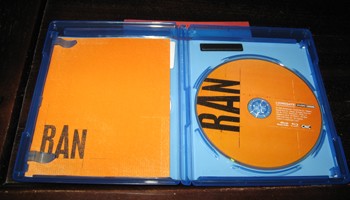 |
Lionsgate's presentation of the StudioCanal Series differ a bit from the versions found in other locations, opting away from the Blu-ray books for the more standard-size packaging. Each one comes with a matte cardboard slipcover, not shiny, that retains the same artwork found in other locations, while a nice-sized booklet with textual information can be found inside each case. Each of the StudioCanal discs have the same aesthetic framework for their Blu-ray menus, containing the same music and coloring for each. Oddly, this presentation for Ran doesn't have the same initial multi-country menu as the StudioCanal presentation for Contempt, though the language and subtitle options are largely similar between the two.
Video and Audio:
Nothing would please me more than to give a full-throated, overwhelmingly positive recommendation of this Blu-ray transfer for Ran, which is properly framed at 1.85:1 within a pleasingly colorful 1080p VC-1 encode, but that's just not going to happen. In short, Kurosawa's film isn't done due diligence here, sporting a wealth of issues that mar this gorgeous film. The most notable issue comes in severe edge enhancement spotted throughout the picture, which creates thick halos around most sequences sporting moderately stark contrast. While on the topic of contrast, many scenes are blown out of proportion and sport some rather unattractive black levels, creating detail-swallowing darkness and overly bright points. Aside from that, we've also got a relatively flat level of dimensionality here and, moreover, a rather abundant level of digital grain that stretches beyond the confines of natural film texture.
There are a few notable upgrades in the image from Criterion's standard-definition presentation, however. Detail has been tightened to an extent here, rendering crisp, clean lines in the set design and against the actors -- when the edge enhancement isn't claiming our focus. Also, many instances of the costume work pop with attractive detail and color gradation in ways that they couldn't before. The cinematography still looks attractive (how could it not) and many of the flesh tones and brash colors are accurate and pleasing; however, that doesn't steer from the impression that Ran looks mostly digital and flat, veering away from delicacy of construction and into a mess of harshness. It's nice to have Ran in high-definition and flow at 24fps, as inherent with the Blu-ray tech, but we could've had a far, far better representation of this stunning film than this. There are a handful of impressive moments that don't fall under its problematic issues (such as a great, somewhat close-up still shot of Nakadai baking in the sun, with horses behind him and his sun / moon staff nearby), but they're very few and far between.
Audio, however, has greatly been improved in this Japanese DTS HD Master Audio track, a nicely-mixed multichannel presentation that surprises with its surround capacity. Ambient effects come streaming from the rear channels, like locusts and birds, along with powerful musical cues. It displays a similarly clear manner to that of Criterion's 2.0 presentation, supporting the raspy high-end swipes of arrows and gunshots to stable, low-distortion degrees. The musical elements during the storm on Hidetora's location at the middle of the film are sumptuous and pleasing, adding a true sense of grandeur to the pivotal sequence. What'll really impress is the nature of billowing fire during this sequence, which begins as gently lapping fire and builds into a crackling, swollen array of flames. Verbal clarity stays crisp and pleasing throughout, naturally a little high-level leaning in quite a few sequences, while the range of middle-range sound effects test the LFE waters water to satisfying degrees. Though the visual presentation leaves something to be desired, this sound option is certainly a robust step above its predecessors. Subtitles, which are crisp white and textually satisfying, are available in a broad range of optional languages -- English, Francais, Deutsch, Castellano, Italiano, Espanol, Nederlands, Dansk, Norsk, Suomi, and Svenska.
Special Features:
 AK (1:11:32, SD MPEG-2):
AK (1:11:32, SD MPEG-2): Previously available on Criterion's two-disc presentation, this documentary from filmmaker Chris Marker (director of La Jetee, the short that 12 Monkeys is based on) is a pensive and calculated feature that remains highly intimate throughout. Behind-the-scenes sequences from the film showcase Kurosawa's directorial methods, while the narrator elucidates the scenes we're watching with further explanations behind his tactics -- such as his need to rehearse for hours for one take. This piece does an interesting job of revealing the costume design from Ran as well, capturing some unique images like samurai strolling between a row of cars. Marker's doc gives us the times and dates for each of the sequences he's photographing, all while making certain to capture Kurosawa instructing his cast and crew excellently. It's a lengthy piece that might require a bit of stop-and-go due to its deliberateness, but the material's excellent.
Akira Kurosawa: The Epic and the Intimate (41:49, SD MPEG-2):
Focus falls on producer Serge Silberman and Kurosawa within this piece, featuring interviews with Ulli Pickardt, Bernard Cohn, Bertrand Raison, Vittorio Dalleore, and others that cover everything about Kurosawa's methodology. They address his focus on actors, the implementation of his simultaneous three-camera arrangements, and how his work has changed throughout the years. They discuss the realism and history behind his productions, concentrating more on Ran as the piece progresses, as well as his laborious and oftentimes obsessive attention to detail. Only footage from Ran, however, appears in the piece.
The Samurai (52:47, SD MPEG-2):
This is, quite simply, an overview of the samurai that also wiggles in elements on how he exists in cinema. It ties authenticity to the genre we're involved in, including the construction behind the weapons, the concept of samurai "looking their best" when going into battle, the ritualistic tea ceremony, and other elements. Samurai fighting techniques and etiquette also make their way roughly halfway into the piece, which includes training involving bokken and learning to use the bow and arrow on horseback. We're given equal doses of history and demonstration, which keeps the doc well-balanced all the way through.
Art of the Samurai (41:11, SD MPEG-2):
Jean-Christophe Charbonnier, a specialist on the topic of Japanese warfare, takes us through the implementation of weaponry, armor, and suicide utilized in Ran. He discusses why certain suicides aren't considered hara kiri, as well as what specific items in the suit of armor mean and how they're constructed. He makes use of a suit of armor next to him to further illustrate his points, which helps when he gets more in-depth. It's a lengthy, drawn-out piece, but still insightful.
Capping off the special features, Ran also comes with a StudioCanal-based Trailer (2:00, SD MPEG-2) that fits the tone of the picture perfectly. The disc has also been enabled with BD-LIVE, but the service wasn't active at the time of this review. Sadly, we're missing a few things here that really bolster the Criterion standard-definition package into something special -- including a nice commentary from Stephen Price, as well as the collection of Kurosawa's paintings illustrated in the Image: Kurosawa's Continuity feature.
Final Thoughts:
Akira Kurosawa directed many, many great films, but he only created a handful of tried-and-true masterworks -- and Ran's one of them. It's a brilliantly tragic take on Shakespeare's "King Lear", one that entrances with its visuals and and knocks one aback with its precision of theatrical delivery. Meticulousness from Kurosawa's eye can be seen within almost every glorious shot, showcasing the beauty that can come from rigid structure and perfectionism. He clearly left the business of crafting epic-scaled theatrical samurai drama with a memorable bang, one that's still as visually and thematically stunning as the day it was first screened at the Tokyo International Film Festival.
It'd be hard not to recommend any version of Ran, but this StudioCanal version comes dangerously close; though the sound quality and special features are both quite good here, the awesome cinematography could've looked a hell of a lot better than what's available in this high-definition presentation. Those who already own Ran via Criterion's stellar two-disc presentation will want to hold onto it, mainly for the special features that aren't on StudioCanal's disc. With that in mind, this Blu-ray of Ran still comes very timidly Recommended as both a supplement to the previous edition and to newcomers, since it improves ever-so-slightly over the standard-definition presentation. However, those that already have a copy of this great film might simply want to weigh whether a give-and-take improvement over the DVD's image, as well as in the special features department, will be worth the time.
|
| Popular Reviews |
| Sponsored Links |
|
|
| Sponsored Links |
|
|
| Release List | Reviews | Shop | Newsletter | Forum | DVD Giveaways | Blu-Ray | Advertise |
|
Copyright 2024 DVDTalk.com All Rights Reserved. Legal Info, Privacy Policy, Terms of Use,
Manage Preferences,
Your Privacy Choices | |||||||









